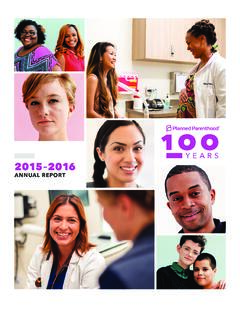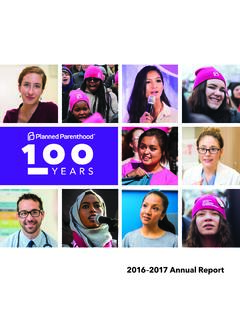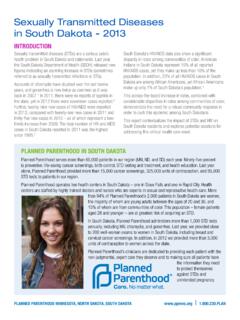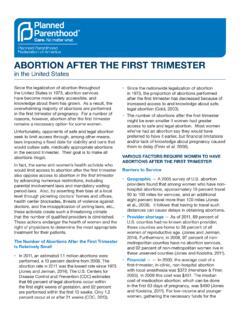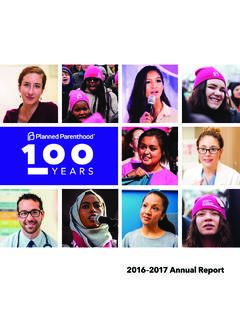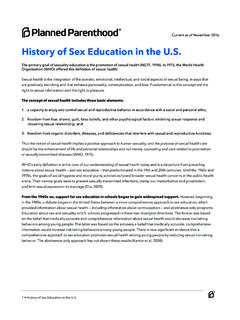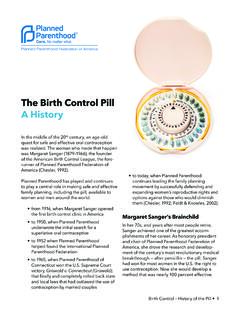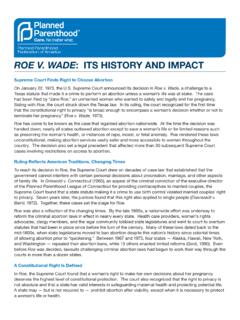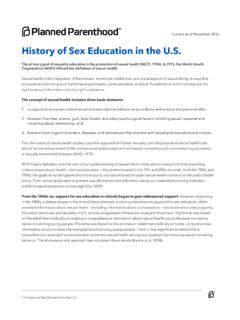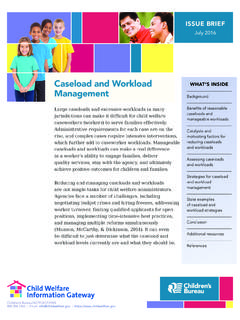Transcription of REDUCING TEENAGE PREGNANCY - Planned Parenthood
1 REDUCING TEENAGE PREGNANCY Although the rate of TEENAGE PREGNANCY in the In 2009, recognizing that evidence-based sex United States is at its lowest level in nearly 40 years, education programs were effective in promoting it remains the highest among the most developed sexual health among teenagers, the Obama countries in the world. Approximately per 1,000 administration transferred funds from the women aged 15 19 nearly 750,000 American Community-based Abstinence Education Program teenagers become pregnant each year (Kost and and budgeted $ million to support evidence- Henshaw, 2012). The majority of these pregnancies based sex education programs across the country. 82 percent are unintended (Finer & Zolna, 2011). The bulk of the funds $75 million was set aside for replicating evidence-based programs that Moreover, because the average age of menarche have been shown to reduce teen PREGNANCY and its has reached an all-time low of about 12 or 13 years underlying or associated risk factors.
2 The balance old (Potts, 1990), and because six out of 10 young was set aside for developing promising strategies, women have sex as teenagers (Martinez et al., 2011), technical assistance, evaluation, outreach, and most TEENAGE girls are at risk of becoming pregnant. program support (Boonstra, 2010). This was the The consequences of adolescent PREGNANCY and first time federal monies were appropriated for more childbearing are serious and numerous: comprehensive sex education programs (SIECUS, ). Pregnant teenagers are more likely than women Though off to a good start, none of these initiatives who delay childbearing to experience maternal can succeed without a general reassessment of the illness, miscarriage, stillbirth, and neonatal death attitudes and mores regarding adolescent sexuality (Luker, 1996). in the Presently, an unrealistic emphasis is Teen mothers are less likely to graduate from placed on preventing adolescent sexual behavior, high school and more likely than their peers who which overlooks the fact that sexual expression is an delay childbearing to live in poverty and to rely on essential component of healthy human development welfare (Hoffman, 2006).
3 For individuals of all ages (Freud; Maslow et al., as cited in Zimbardo, 1992). The majority of the public The children of TEENAGE mothers are often recognizes this fact 63 percent of Americans born at low birth weight, experience health and believe that sexual exploration among young people developmental problems, and are frequently poor, is a natural part of growing up (SIECUS, 1999). abused, and/or neglected (Hoffman & Maynard, 2008; Martin et al., 2011; NCPTUP, 2010.). An influential minority of individuals promote unrealistic, abstinence-only programs and parental TEENAGE PREGNANCY poses a substantial financial consent requirements for obtaining contraception burden to society, estimated at $ billion that deny American teens accurate information about annually in lost tax revenues, public assistance, and confidential access to family planning services child health care, foster care, and involvement with to prevent PREGNANCY . However, even individuals the criminal justice system (NCPTUP, 2011).
4 Who support abstinence-only programs and parental As a result, the United States needs a number of consent recognize the dangers of such measures. initiatives to reduce its TEENAGE PREGNANCY rate and the negative outcomes that accompany it. These Planned Parenthood believes that it is important to initiatives should incorporate responsible, medically help teens delay having sexual intercourse, but it accurate sex education and information in the also believes that policymakers must accept the fact schools and in the media, improvements in funding that teens engage in sexual behavior, and they must for and access to family planning services, and youth initiate and provide funding for various programs development programs to improve the life options of and interventions that will facilitate responsible impoverished teens. sexual behavior. Sex Education Can Help Prevent The Majority of Americans Support TEENAGE PREGNANCY Sex Education that is Responsible and Medically Accurate Sex education that is responsible and medically accurate, begins in kindergarten, and continues in Three decades of national polling has shown that an age-appropriate manner through the 12th grade the vast majority of Americans, especially American is necessary given the early ages at which young parents, have long supported comprehensive, people are initiating intercourse percent of medically accurate sex education (Harper, 1981).
5 Students nationwide report having sex before the age During this time, the overwhelming majority of of 13, percent by grade 10, and percent by Americans have wanted their children to receive grade 12 (CDC, 2012). In fact, the most successful sex education that includes a variety of subjects, programs aimed at REDUCING TEENAGE PREGNANCY are including communications and coping skills, the those targeting younger adolescents who are not yet emotional aspects of sexual relationships, sexually sexually experienced (Frost & Forrest, 1995). transmitted infections including HIV/AIDS, how to use contraception (85 percent) and condoms (84. Sex education programs that are balanced and percent), sexual orientation (76 percent), abortion realistic, encourage students to postpone sex until (79 percent), and the consequences of becoming they are older, and promote safer-sex practices sexually active (94 percent) (KFF, 2000). Only 36. among those who choose to be sexually active have percent of Americans have supported abstinence- been proven effective at delaying first intercourse only educational programs (Bleakley et al.)
6 , 2006), and increasing use of contraception among sexually and 56 percent of Americans have not believed active youth. These programs have not been shown that abstinence-only programs prevent sexually to initiate early sexual activity or to increase levels of transmitted infections or unintended pregnancies sexual activity or numbers of sexual partners among (Research!America and APHA, 2004). sexually active youth (Kirby, 2007; Kohler et al., 2008). Additional studies have shown that parental opinions Many sex education programs in the United States regarding sex education are similar between states caution young people to not have sex until they that teach comprehensive sex education and states are married (Landry et al., 1999). However, most that mandate abstinence-only programs. abstinence-only programs are not effective because they fail to delay the onset of intercourse and often A 2006 survey of parents in North Carolina a provide information that is medically inaccurate and state that mandates abstinence-only education potentially misleading (Kirby, 2007; Kohler et al.
7 , found that 91 percent of parents support 2008; Lin & Santelli, 2008; Trenholm et al., 2007). sex education in the schools, with 89 percent Only 11 states plus the District of Columbia require supporting comprehensive sex education . sex education that includes information about including discussions of sexual orientation, oral contraception. Six other states require that if sex sex, and anal sex (Ito et al., 2006). education is provided, it must include information A 2007 survey of California parents found that about contraception (Guttmacher Institute, 2013c). regardless of educational attainment, political or Recent studies show that more teens receive formal religious affiliation, or place of residence, nearly sex education on how to say no to sex (87 percent 90 percent believe their children should have of teen women and 81 percent of teen men) than on comprehensive sex education in the classroom contraception methods (70 percent of teen women (Mangaliman, 2007).
8 And 62 percent of teen men) (Martinez et al., 2010). A 2011 study of parents in Harris County, Texas the third most populous county in the found that a majority supports sex education in middle school that would include unaware that having an STI increases the risk of abstinence messages as well as medically getting HIV (KFF, 2003). Another survey found that accurate information and instruction on the use the majority (86 percent) of teens aged 12-19 say of condoms and other kinds of contraception. they have all the information they need to avoid Despite the desires of parents, however, nearly an unintended PREGNANCY . Yet only 36 percent three out of four Texas school districts implement say they know a lot or everything about birth abstinence-only programs that have no evidence control pills and how to use them, and 36 percent of effectiveness (Texas Freedom Network, 2011; say they know only a little or nothing about Tortolero, 2011). condoms (Albert, 2012). A recent study in Mississippi showed that 92 Sixty-three percent of teens aged 15 17 would percent of Mississippi parents support abstinence- like more information on the different methods plus sex education in schools.
9 In this state of contraception available; 29 percent would like with the highest teen PREGNANCY and gonorrhea more information on how to use condoms; and 59. rates in the country the overwhelming majority percent would like more information on where to of parents want to move from abstinence-only go to get tested for HIV and other STIs (KFF, 2003). programs to abstinence-plus curricula that include Forty-nine percent of young people aged 12 19. information about birth control, relationships, and wish that young people received more information sexually transmitted infections (McKee, 2011). about both abstinence and contraception rather Every reputable sex education organization in the than just one or the other (Albert, 2012). , as well as prominent health organizations Half of teens have not heard of emergency including the American Medical Association, contraception and do not know that there is has denounced abstinence-only programs. For something a woman can do to prevent PREGNANCY example, a 1997 consensus statement from after unprotected sex.
10 More than a quarter of the National Institutes of Health concluded that teens incorrectly believe that birth control pills legislation discouraging condom use on the grounds provide protection from STIs, including HIV/AIDS. that condoms are ineffective places policy in (KFF, 2003). direct conflict with science because it ignores overwhelming evidence Abstinence-only programs Sex Education Is a Success in cannot be justified in the face of effective programs Other Developed Nations and given the fact that we face an international European countries have already demonstrated great emergency in the AIDS epidemic (NIH, 1997). success with sex education. For example: The National Coalition to Support Sexuality The Netherlands, where sex education begins Education now has over 140 member organizations in preschool and is integrated into all levels and that include the American Medical Association, the subjects of schooling, boasts one of the lowest American Public Health Association, the American teen birth rates in the world per 1,000.
